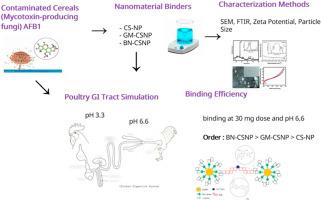壳聚糖纳米颗粒及其复合材料对黄曲霉毒素B1在模拟家禽肠道中的吸附效果研究
IF 2.4
4区 医学
Q2 PHARMACOLOGY & PHARMACY
引用次数: 0
摘要
真菌毒素是产毒真菌产生的次生代谢物,主要在谷类作物上。其中,黄曲霉毒素B1 (AFB1)危害最大,具有致癌性、制毒性和诱变性作用,对鸟类和人类构成严重威胁。以前,已经使用了各种控制策略来控制黄曲霉中毒,但需要使用共同的替代策略来减少黄曲霉中毒的影响。因此,本研究计划在体外培养基中考察壳聚糖、葡甘露聚糖和膨润土等不同粘结剂在纳米材料和纳米复合材料中的结合效率,以帮助吸附黄曲霉毒素。首先,制备了壳聚糖纳米颗粒(CS-NP)和壳聚糖基纳米复合材料,包括负载葡甘露聚糖(gmcsnp)和负载膨润土(BN-CSNP),并利用扫描电镜(SEM)、zeta施胶、多分散指数(PDI)、zeta电位和傅里叶变换红外光谱(FTIR)对其形貌进行了表征。设计了家禽体外胃肠模型,评估了3种吸附剂(CS-NP、GM-CSNP和BN-CSNP)对AFB1的吸附效果。该模型模拟了两种不同的pH条件:砂囊和前心室(pH 3.3)和小肠(pH 6.6)。这些吸附剂以三种不同剂量(10、15和20毫克)对100 ppb AFB1进行了测试。同样,对于200ppb AFB1,使用两种浓度的吸附剂25和30 mg。体外实验结果表明,三种纳米材料(CS-NP、GM-CSNP和BN-CSNP)均能与AFB1结合。在pH值为6.6时,纳米形式的粘结剂的结合率最高。在剂量率为30mg时,每种纳米材料的最大结合率高达98%。在所有候选结合物中,BN-CSNP与AFB1结合程度最高,其次是GM-CSNP和BN-CSNP。本研究介绍了一种创新的纳米方法,展示了壳聚糖及其杂化纳米复合材料如何通过提高在胃肠道介质中的结合亲和力和稳定性来提高黄曲霉毒素的解毒效率。本文章由计算机程序翻译,如有差异,请以英文原文为准。

Harnessing the adsorption efficiency of chitosan nanoparticles and its hybrid nanocomposites against aflatoxin B1 in simulated poultry gut conditions
Mycotoxins are secondary metabolites produced by toxigenic fungi, primarily on cereal crops. Among them, aflatoxins B1 (AFB1) is the most dangerous, with carcinogenic, toxigenic and mutagenic effects that pose serious risk to birds and humans. Previously, various control strategies have been used to control aflatoxicosis but there is need to use common alternative strategies to reduce the impact of aflatoxicosis. Therefore, the present study has been planned to check the binding efficiency of different binders such as chitosan, glucomannan and bentonite in nanomaterials and nanocomposites form in in-vitro medium to aid in adsorption of aflatoxins. Initially, the chitosan nanoparticles (CS-NP) and chitosan based nanocomposites, including glucomannan-loaded (GM-CSNP) and bentonite-loaded (BN-CSNP) were prepared and characterized for their morphology using scanning electron microscopy (SEM), zeta sizing, poly dispersity index (PDI), zeta potential and Fourier transform infrared spectroscopy (FTIR). An in-vitro gastrointestinal model for poultry was designed to assess the efficacy of three adsorbents (CS-NP, GM-CSNP and BN-CSNP) against AFB1. The model simulated two distinct pH conditions: the gizzard and proventriculus (pH 3.3) and the small intestine (pH 6.6). These adsorbents were tested at three different doses (10, 15 and 20 mg) for 100 ppb AFB1. Similarly, for 200 ppb AFB1 two concentrations of adsorbents 25 and 30 mg were used. Results of in-vitro experiments showed that all three nanomaterials (CS-NP, GM-CSNP and BN-CSNP) have binding with the AFB1. The highest binding of each binder in nanoforms was noted at pH 6.6. Maximum binding up to 98 % of each nanomaterial was observed at dose rate of 30 mg. Among all the candidate binders BN-CSNP revealed highest binding with AFB1 followed by GM-CSNP and BN-CSNP. This study introduce an innovative nano approach, demonstrating how chitosan and its hybrid nanocomposites can enhance aflatoxins detoxification efficiency through improved binding affinity and stability in gastrointestinal medium.
求助全文
通过发布文献求助,成功后即可免费获取论文全文。
去求助
来源期刊

Toxicon
医学-毒理学
CiteScore
4.80
自引率
10.70%
发文量
358
审稿时长
68 days
期刊介绍:
Toxicon has an open access mirror Toxicon: X, sharing the same aims and scope, editorial team, submission system and rigorous peer review. An introductory offer Toxicon: X - full waiver of the Open Access fee.
Toxicon''s "aims and scope" are to publish:
-articles containing the results of original research on problems related to toxins derived from animals, plants and microorganisms
-papers on novel findings related to the chemical, pharmacological, toxicological, and immunological properties of natural toxins
-molecular biological studies of toxins and other genes from poisonous and venomous organisms that advance understanding of the role or function of toxins
-clinical observations on poisoning and envenoming where a new therapeutic principle has been proposed or a decidedly superior clinical result has been obtained.
-material on the use of toxins as tools in studying biological processes and material on subjects related to venom and antivenom problems.
-articles on the translational application of toxins, for example as drugs and insecticides
-epidemiological studies on envenoming or poisoning, so long as they highlight a previously unrecognised medical problem or provide insight into the prevention or medical treatment of envenoming or poisoning. Retrospective surveys of hospital records, especially those lacking species identification, will not be considered for publication. Properly designed prospective community-based surveys are strongly encouraged.
-articles describing well-known activities of venoms, such as antibacterial, anticancer, and analgesic activities of arachnid venoms, without any attempt to define the mechanism of action or purify the active component, will not be considered for publication in Toxicon.
-review articles on problems related to toxinology.
To encourage the exchange of ideas, sections of the journal may be devoted to Short Communications, Letters to the Editor and activities of the affiliated societies.
 求助内容:
求助内容: 应助结果提醒方式:
应助结果提醒方式:


